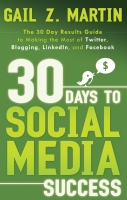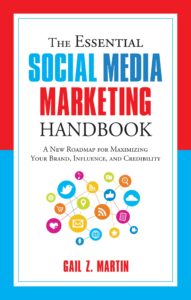 by Gail Z. Martin excerpted from 30 Days to Social Media Success
by Gail Z. Martin excerpted from 30 Days to Social Media Success
Should you send out your press release to news sites or post it on social media? The answer is: both. Social media is just a new vehicle for the oldest form of news—word of mouth. The difference lies in the style of the communication and the relationship with the audience.
Although their influence has waned, traditional news outlets remain important for publicity-seekers. But where it used to require mailing, emailing or calling a reporter, now it’s possible to find a reporter’s social media sites and strike up a conversation in a less formal and more accessible setting. Reporters and TV/radio hosts now blog, Tweet and post Facebook pages, all of which make it possible to comment or connect outside of traditional channels. The key difference is that connections made via social media should be conversational, while the real pitch should be made via traditional channels such as email or phone.
Today’s corporate press pages often include blogs, Twitter feeds, YouTube videos and web audio, and offer reporters the chance to subscribe via an RSS feed. You can create a similar one-stop media (and consumer) page on your web site and incorporate your social media sites to provide a content-rich introduction to you and your products or services.
Online press distribution sites (whether they are pay-for-placement or free posting) are a great way to increase traffic to both your web site and your social media sites. The last paragraph of a press release is called the “boilerplate;” it’s copy that stays the same from release to release and it includes a brief company description and your contact information. When you write releases that are designed to catch the interest of both reporters and consumers, you can steer them to visit your other sites for more information or for immediate sales. Press releases that you post online do two very valuable things: they increase your brand’s search engine visibility and they improve your site’s rankings through increased traffic and in-bound links.
The biggest difference between news and social media is in the context and style of the communication. Most newspapers and magazines (whether online or traditional paper) write in a third-person narrative form. This is ideal for the traditional press release. Social media sites, however, are conversation and informal. As a general rule, bloggers and social media site owners don’t appreciate getting press releases. They would rather be approached with a personal email or a direct message and a conversational inquiry to see whether the topic would be of interest. News sites tend to cover events, products and announcements in a detached, impersonal style, which is ideally as unbiased as possible. Social media sites revel in their quirky personality and imbue everything with the voice and perspective of the site owner. Traditional news sites also tend to show more restraint in terms of emotion and avoid the use of profanity. Social media sites are wide-open forums that can range from restrained to no-holds-barred.
When a story, image or video goes “viral” it means that it so captures the imagination that people begin to send it to their friends without prompting. Sometimes, a viral story or image will also make it only the traditional news if it gains enough popularity. It’s important to remember that all PR, viral or not, occurs with a complete lack of control on the part of the originator after the “send” button has been pressed. You may not like what a reporter or blogger says about your company or your product, and you may not approve of the contexts in which your viral image or story is relayed. Too bad. That’s how the game is played.
Leveraging PR and social media
When you use traditional PR and social media to reinforce each other, utilizing the unique strengths of both vehicles, your publicity can take a huge step forward.
Before you pitch a reporter, check out his or her social media sites. Make thoughtful comments that include a good signature block and reference your company/product/book in a non-sales way. If there are a few key reporters you want to target, you can begin this process long before your release is ready to go live.
Create a blog just for your press releases, and use RSS to feed it to your web site and social media pages so that your news is both easily updated and archived. A news blog also provides the option for interested reporters or citizen journalists to subscribe for future updates. Remember to include your videos and audios as well as your standard press releases.
When you post a press release to an online distribution site, make sure the headlines and copy are keyword-rich for optimum searchability, and have good links to your web site and social media pages. Take readers directly to the appropriate page for the topic, not just to the home page of your site. Don’t forget to fill in the “tags” section where you can increase searchability even further. When your press release posts online, be sure to add it to the Social Bookmarking sites for increased visibility.
When you have an article, radio interview or guest blog posted online, Tweet the link and let your Facebook and LinkedIn friends know by updating your “status” line. Blog about the experience of being interviewed, or augment the article or interview with additional information you didn’t have a chance to share and be sure to include the link. Add the link to your online press kit with a tag that shows the name of the publication/blog/station and the date. Be sure to submit article/interview links to the Social Bookmarking sites like StumbleUpon, too.
Create news by blogging live from industry events and creating on-site videos and uploading them. Run polls or surveys on your social media sites, and report the results with a press release to traditional and online news sites. Friend and follow the reporters and bloggers you hope to pitch, and pay attention to the kinds of topics they discuss and cover on their social media sites as well as in their articles, shows or blogs. Become part of the news by launching your own newsworthy podcast or blog and post solid, non-sales content that attracts the attention of traditional and online media.
While the lines between news and social media have blurred, consumers benefit from a windfall of information, while companies seeking publicity have more opportunities than ever before. Social media can not only increase the effectiveness of your publicity; it can create a powerful, interconnected and global PR platform for you and your business. Remember to entertain and inform and keep the focus of releases on “what’s in it for the reader” to get maximum impact.






